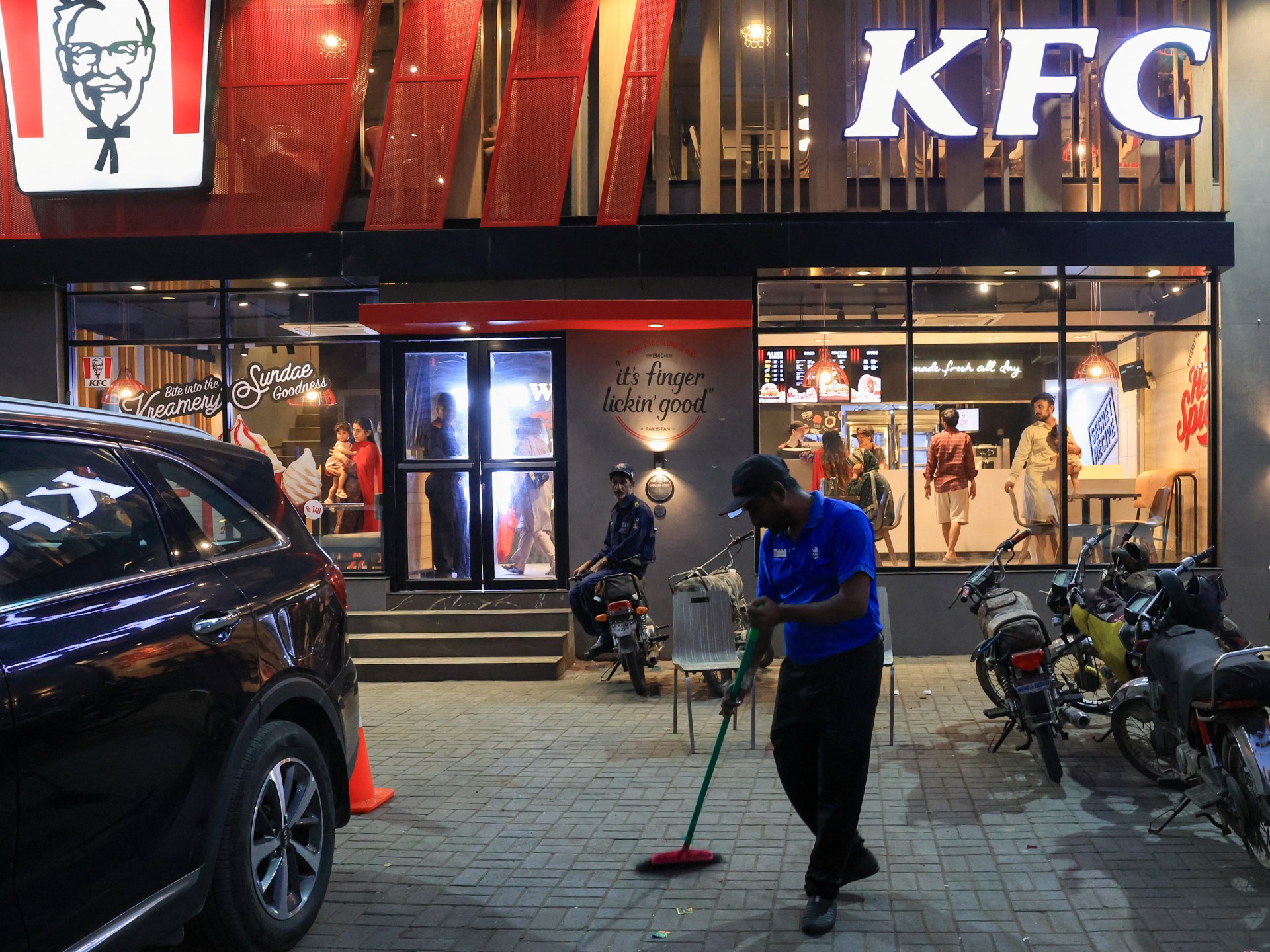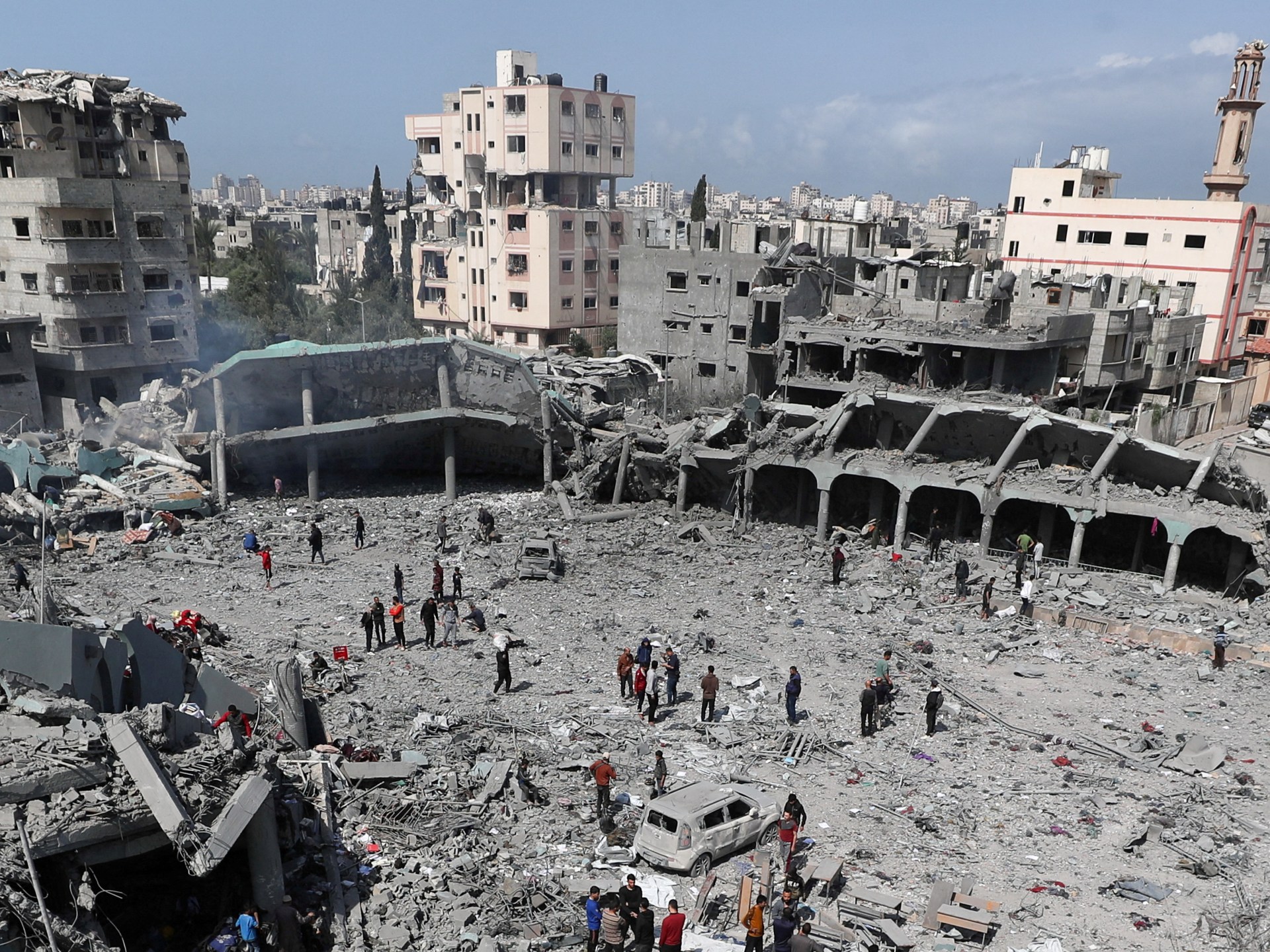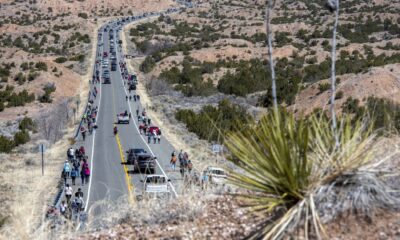Middle East
Iran says progress in nuclear talks with US, confirms third round next week | News

After technical talks, senior negotiators expected to reunite on April 26, according to Iran’s foreign ministry.
Iran and the United States have completed a second round of indirect nuclear negotiations, which Iran’s foreign minister has described as “constructive” and moving forward with further meetings planned in the coming week.
Abbas Araghchi and US Middle East envoy Steve Witkoff held four hours of indirect talks at Oman’s embassy in the Italian capital, Rome, on Saturday, according to Araghchi.
“We succeeded in reaching a better understanding on certain principles and goals,” the diplomat was quoted by the semiofficial Tasnim news agency as saying. “The negotiations were conducted in a constructive atmosphere and are progressing.”
There has been no readout yet of the meeting from the US side.
The delegations – led by Araghchi and Witkoff, a billionaire real estate executive whom US President Donald Trump has dispatched on numerous foreign policy missions – stayed in separate rooms in the embassy as Omani Foreign Minister Badr al-Busaidi shuttled messages between them, according to Iranian officials.
Iran’s Ministry of Foreign Affairs said the parties will hold more indirect, technical-level talks in the coming days, followed by another meeting with senior officials on April 26.
There were useful indirect talks today between Iran and the United States conducted by Oman Foreign Minister in a constructive atmosphere.
The two sides agreed to continue the indirect talks in few days at technical level to be followed by another round at their own level on…
— Esmaeil Baqaei (@IRIMFA_SPOX) April 19, 2025
“I hope that after next week’s technical sessions, we’ll be in a better position,” Araghchi said, according to Tasnim. “There’s no reason for excessive optimism or pessimism.”
‘Negotiations to pick up’
Al Jazeera’s James Bays, reporting near the Omani diplomatic compound in Rome, said the Iranian response was “very positive” for a delegation that “had seemed pretty negative going into the talks”.
Next week’s planned talks mean “the pace of negotiations is going to be picked up”, Bays said.
The latest meeting comes a week after Iran and the US came together in Muscat for their first high-level discussions since Trump in 2018 unilaterally abandoned a landmark nuclear accord signed and brokered by world powers in 2015.
The Iranians “are looking for a kind of consistency when it comes to the current talks”, Al Jazeera’s Tohid Asadi reported from Tehran.
Will US accept civilian nuclear programme?
Western governments, including the US, have long accused Iran of seeking to develop nuclear weapons – an allegation Tehran has denied, insisting its nuclear programme is solely for peaceful civilian use. On Wednesday, the head of the International Atomic Energy Agency, Rafael Grossi, said Iran was “not far” from possessing a nuclear weapon.
Grossi was also in Rome on Saturday meeting Italian Foreign Minister Antonio Tajani. Grossi’s nuclear watchdog would likely be central in verifying compliance by Iran should a deal be reached, as it did with the 2015 accord.
The US and Iran have had no diplomatic relations since shortly after Iran’s 1979 Islamic Revolution. After returning to office in January, Trump revived his “maximum pressure” sanctions campaign against Tehran, but in March, he sent a letter to Iranian Supreme Leader Ali Khamenei calling for renewed negotiations – while warning of military consequences if diplomacy fails.
“I’m not in a rush” to use force, Trump said on Thursday. “I think Iran wants to talk.”
On Friday, Araghchi said the US showed “a degree of seriousness” during the first round of talks but questioned Washington’s “intentions and motivations”.
Bays said the heart of the dispute remains whether Iran may maintain a civilian nuclear programme – or whether, as hardliners in Washington insist, it must dismantle its nuclear programme entirely.
“All they’ve been talking about last week in Muscat and here in Rome is a framework for the discussions and what they want to achieve,” Bays said. “They have not been discussing the nuclear detail, … and the devil is in the detail on these things.”
Middle East
Over 170 arrested for attacks on Pakistan KFC outlets in Gaza war protests | Israel-Palestine conflict News

Western brands have been hit by boycotts and other forms of protests in Muslim-majority countries due to the Gaza war.
Police have arrested close to 200 people in Pakistan in recent weeks after more than 10 group attacks on outlets of the United States-based fast-food chain KFC, sparked by anti-US sentiment, unconditional US backing for Washington’s close ally Israel and opposition to Israel’s war in Gaza, officials say.
The fast-food chain has become a target of protest and boycott calls by Islamist parties since the start of the war in Gaza as they link the brand to US support for Israel.
At least 178 people have been arrested, the officials said this week.
Police in major cities in Pakistan – including the southern port city of Karachi, the eastern city of Lahore and the capital, Islamabad – confirmed at least 11 incidents in which KFC chicken restaurants were attacked by protesters armed with sticks and vandalised.
A police official, who spoke on condition of anonymity, said one KFC employee was shot and killed this week in a store on the outskirts of Lahore by unknown gunmen. The official added there was no protest at the time and police were investigating whether the killing was politically motivated or for some other reason.
In Lahore, police said they were ramping up security at 27 KFC outlets after two attacks took place and five were prevented.
“We are investigating the role of different individuals and groups in these attacks,” Faisal Kamran, a senior Lahore police officer told the Reuters news agency, adding that 11 people, including a member of the Islamist party Tehreek-e-Labbaik Pakistan (TLP), have been arrested in the city. He added the protests were not officially organised by the TLP.
TLP spokesman Rehan Mohsin Khan said the group “has urged Muslims to boycott Israeli products, but it has not given any call for protest outside KFC”.
“If any other person claiming to be a TLP leader or activist has indulged in such activity, it should be taken as his personal act which has nothing to do with the party’s policy,” Khan said.
Western brands have been hit by boycotts and other forms of protests in Pakistan, other Muslim-majority countries and several Western nations over Israel’s military offensive in the Gaza Strip.
In February last year, McDonald’s cited boycott campaigns in the Middle East, Indonesia and Malaysia for sales growing just 0.7 percent during the fourth quarter of 2023, compared with 16.5 percent growth in the same quarter the previous year.
Unilever – which produces Dove soap, Ben & Jerry’s ice cream and Knorr stock cubes – also said sales in Indonesia in the same quarter had experienced a double-digit decline as a result of “geopolitically focused, consumer-facing campaigns”.
A KFC restaurant in the Pakistan-administered region of Kashmir was also set on fire in March last year as protesters chanted “Free Palestine.”
More than 51,900 people have been killed in Gaza during Israel’s war, which began 18 months ago.
At least 1,139 people were killed in Israel during the Hamas-led attacks of October 7, 2023, and more than 200 were taken captive.
KFC and its parent company Yum Brands have not yet responded to news of the arrests in Pakistan.
Middle East
Israeli bombardment of Gaza kills 92 in two days: Health Ministry | Israel-Palestine conflict News
At least 219 people have also been injured in attacks since Good Friday, with many children among the casualties, according to health officials.
Israeli attacks have killed 92 Palestinians in the Gaza Strip over the past two days, according to the territory’s Ministry of Health.
The attacks, which took place on April 17-19, have also left at least 219 people wounded and hospitalised, the ministry said in a statement on Saturday, with dozens more still trapped under the rubble or in areas that rescuers are unable to reach.
The surge in bloodshed comes as Israel presses a six-week aid blockade and demands that Hamas disarm before any truce can be agreed. The armed group has flatly refused the demand and insists a permanent ceasefire must be part of any deal.
At least 15 children, hit during an overnight air raid on tents in Khan Younis, were among the casualties, according to the statement. A raid on Rafah killed a mother and her daughter alongside two others, according to the European Hospital where their bodies were taken.
“For the vast majority of civilians, nighttime is the time of horror and unrelenting pain,” said Al Jazeera’s Tareq Abu Azzoum, reporting from central Gaza. “Nobody is safe in their homes, in the makeshift tents, in displacement camps.”

‘Less than a meal a day’
After restarting its military campaign on March 18 following a brief ceasefire, Israel has pledged to intensify its 18-month war on Gaza and occupy large “security zones” inside the Strip.
Since March 2, it has also blocked the entry of food, fuel and aid into the enclave, defying an order by the International Court of Justice (ICJ) that it must allow humanitarian access.
Aid groups warn food is running out.
“Kids are eating less than a meal a day and struggling to find their next meal,” said Bushra Khalidi, policy head of Oxfam. “Malnutrition and pockets of famine are definitely occurring in Gaza.”
Earlier this week, Hamas rejected an Israeli proposal to pause fighting for 45 days if the Palestinian group releases 10 live captives and agrees to disarm.
“The request to disarm Hamas is not acceptable to even hear,” senior Hamas official Sami Abu Zuhri said. “This is not just a red line. It is a million red lines.”
Hamas has offered to free all remaining captives – believed to be about 58 although several are dead – in return for a permanent end to the war and the Israeli army’s full withdrawal.
The death toll in Gaza has now reached 51,065, with 116,505 wounded, according to the Health Ministry.
“We can see the very psychological toll in the city on the faces of everyone here, people are walking very exhausted, traumatised,” said Abu Azzoum. “They are thinking about the dark future that awaits them.”
Middle East
Gaza had educational justice. Now the genocide has wiped that out, too | Education

Palestinians have always been passionate about learning. During the Ottoman era, Palestinian students travelled to Istanbul, Cairo, and Beirut to pursue higher education. During the British Mandate, in the face of colonial policies aimed at keeping the local population ignorant, Palestinian farmers pooled their resources and established schools of their own in rural areas.
Then came the Nakba, and the occupation and displacement brought new pain that elevated the Palestinian pursuit of education to an entirely different level. Education became a space where Palestinians could feel their presence, a space that enabled them to claim some of their rights and dream of a better future. Education became hope.
In Gaza, instruction was one of the first social services established in refugee camps. Students would sit on the sand in front of a blackboard to learn. Communities did everything they could to ensure that all children had access to education, regardless of their level of destitution. The first institution of higher education in Gaza – the Islamic University – held its first lectures in tents; its founders did not wait for a building to be erected.
I remember how, as a child, I would see the alleys of our neighbourhood every morning crowded with children heading to school. All families sent their children to school.
When I reached university age, I saw the same scene: Crowds of students commuting together to their universities and colleges, dreaming of a bright future.
This relentless pursuit of education, for decades, suddenly came to a halt in October 2023. The Israeli army did not just bomb schools and universities and burn books. It destroyed one of the most vital pillars of Palestinian education: Educational justice.
Making education accessible to all
Before the genocide, the education sector in Gaza was thriving. Despite the occupation and blockade, we had one of the highest literacy rates in the world, reaching 97 percent. The enrolment rate in secondary education was 90 percent, and the enrolment in higher education was 45 percent.
One of the main reasons for this success was that education in Gaza was completely free in the primary and secondary stages. Government- and UNRWA-run schools were open to all Palestinian children, ensuring equal opportunities for everyone.
Textbooks were distributed for free, and families received support to buy bags, notebooks, pens, and school uniforms.
There were also many programmes sponsored by the Ministry of Education, UNRWA, and other institutions to support talented students in various fields, regardless of their economic status. Reading competitions, sports events, and technology programmes were organised regularly.
At the university level, significant efforts were made to make higher education accessible. There was one government university which charged symbolic fees, seven private universities with moderate to high fees (depending on the college and major), and five university colleges with moderate fees. There was also a vocational college affiliated with UNRWA in Gaza that offered fully free education.
The universities provided generous scholarships to outstanding and disadvantaged students.
The Ministry of Education also offered internal and external scholarships in cooperation with several countries and international universities. There was a higher education loan fund to help cover tuition fees.
Simply put, before the genocide in Gaza, education was accessible to all.
The cost of education amid genocide
Since October 2023, the Zionist war machine has systematically targeted schools, universities, and educational infrastructure. According to UN statistics, 496 out of 564 schools – nearly 88 percent – have been damaged or destroyed. In addition, all universities and colleges in Gaza have been destroyed. More than 645,000 students have been deprived of classrooms, and 90,000 university students have had their education disrupted.
As the genocide continued, the Ministry of Education and universities tried to resume the educational process, with in-person classes for schoolchildren and online courses for university students.
In displacement camps, tent schools were established, where young volunteers taught children for free. University professors used online teaching tools like Google Classroom, Zoom, WhatsApp groups, and Telegram channels.
Despite these efforts, the absence of regular education created a significant gap in the educational process. The incessant bombardment and forced displacement orders issued by the Israeli occupation made attendance challenging. The lack of resources also meant that tent schools could not provide proper instruction.
As a result, paid educational centres emerged, offering private lessons and individual attention to students. On average, a centre charges between $25 to $30 per subject per month, and with eight subjects, the monthly cost reaches $240 – an amount most families in Gaza cannot afford.
In the higher education sector, cost also became prohibitive. After the first online semester, which was free, universities started requiring students to pay portions of their tuition fees to continue distance learning.
Online education also requires a tablet or a computer, stable internet access, and electricity. Most students who lost their devices due to bombing or displacement cannot buy new ones because of the high prices. Access to stable internet and electricity at private “workspaces” can cost as much as $5 an hour.
All of this has led many students to drop out due to their inability to pay. I, myself, could not complete the last semester of my degree.
The collapse of educational justice
A year and a half of genocide was enough to destroy what took decades to build in Gaza: Educational justice. Previously, social class was not a barrier for students to continue their education, but today, the poor have been left behind.
Very few families can continue educating all their children. Some families are forced to make difficult decisions: Sending older children to work to help fund the education of the younger ones, or giving the opportunity only to the most outstanding child to continue studying, and depriving the others.
Then there are the extremely poor, who cannot send any of their children to school. For them, survival is the priority. During the genocide, this group has come to represent a large portion of society.
The catastrophic economic situation has forced countless school-aged children to work instead of going to school, especially in families that lost their breadwinners. I see this painful reality every time I step out of my tent and walk around.
The streets are full of children selling various goods; many are exploited by war profiteers to sell things like cigarettes for a meagre wage.
Little children are forced to beg, chasing passersby and asking them for anything they can give.
I feel unbearable pain when I see children, who just a year and a half ago were running to their schools, laughing and playing, now stand under the sun or in the cold selling or begging just to earn a few shekels to help their families get an inadequate meal.
For Gaza’s students, education was never just about getting an academic certificate or an official paper. It was about optimism and courage, it was a form of resistance against the Israeli occupation, and a chance to lift their families out of poverty and improve their circumstances. Education was life and hope.
Today, that hope has been killed and buried under the rubble by Israeli bombs.
We now find ourselves in a dangerous situation, where the gap between the well-to-do and the poor is widening, where an entire generation’s ability to learn and think is being diminished, and where Palestinian society is at risk of losing its identity and its capacity to continue its struggle.
What is happening in Gaza is not just a temporary educational crisis, but a deliberate campaign to destroy opportunities for equality and create an unbalanced society deprived of justice.
We have reached a point where the architects of the ongoing genocide are confident in the success of their strategy of “voluntary transfer” – pushing Palestinians to such depths of despair that they choose to leave their land voluntarily.
But the Palestinian people still refuse to let go of their land. They are persevering. Even the children, the most vulnerable, are not giving up. I often think of the words I overheard from a conversation between two child vendors during the last Eid. One said: “There is no joy in Eid.” The other one responded: “This is the best Eid. It’s enough that we’re in Gaza and we didn’t leave it as Netanyahu wanted.”
Indeed, we are still in Gaza, we did not leave as Israel wants us to, and we will rebuild just as our ancestors and elders have.
The views expressed in this article are the author’s own and do not necessarily reflect Al Jazeera’s editorial stance.
-

 Education1 day ago
Education1 day agoHarvard’s battle with the Trump administration is creating a thorny financial situation
-

 Lifestyle2 days ago
Lifestyle2 days agoThousands of pilgrims trek through New Mexico desert to historic adobe church for Good Friday
-

 Middle East14 hours ago
Middle East14 hours agoTunisian court hands opposition figures lengthy jail terms | Human Rights News
-

 Conflict Zones1 day ago
Conflict Zones1 day agoTrump says US may ‘pass’ on helping end war if Russia, Ukraine resist deal | Russia-Ukraine war News
-

 Europe1 day ago
Europe1 day agoTrump’s ‘lone ranger’: How Steve Witkoff became the defacto point man on America’s foreign policy challenges
-

 Lifestyle1 day ago
Lifestyle1 day agoSweets from the sky! A helicopter marshmallow drop thrills kids in suburban Detroit
-

 Sports2 days ago
Sports2 days agoAaron Rodgers ‘not holding anybody hostage’ as he decides his future, retirement a possibility
-

 Sports2 days ago
Sports2 days agoManchester United pulls off ‘miracle’ Europa League victory against Lyon




